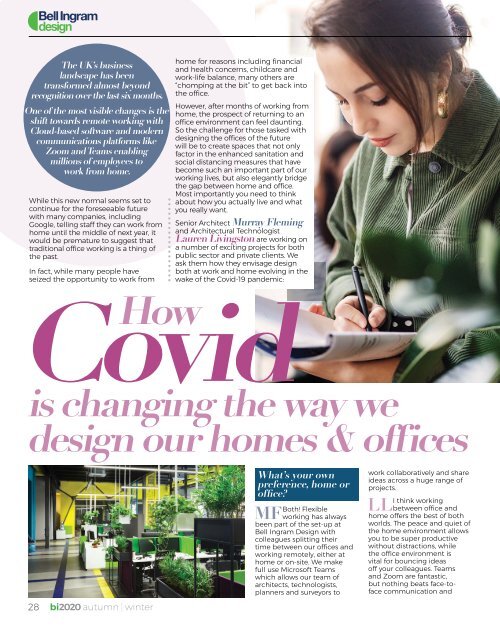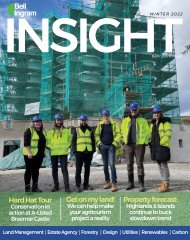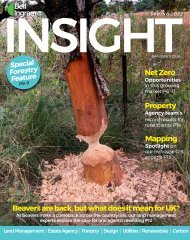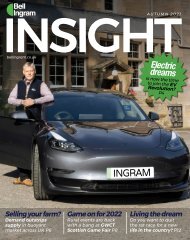You also want an ePaper? Increase the reach of your titles
YUMPU automatically turns print PDFs into web optimized ePapers that Google loves.
design<br />
design<br />
The UK’s business<br />
landscape has been<br />
transformed almost beyond<br />
recognition over the last six months.<br />
One of the most visible changes is the<br />
shift towards remote working with<br />
Cloud-based software and modern<br />
communications platforms like<br />
Zoom and Teams enabling<br />
millions of employees to<br />
work from home.<br />
While this new normal seems set to<br />
continue for the foreseeable future<br />
with many companies, including<br />
Google, telling staff they can work from<br />
home until the middle of next year, it<br />
would be premature to suggest that<br />
traditional office working is a thing of<br />
the past.<br />
home for reasons including financial<br />
and health concerns, childcare and<br />
work-life balance, many others are<br />
“chomping at the bit” to get back into<br />
the office.<br />
However, after months of working from<br />
home, the prospect of returning to an<br />
office environment can feel daunting.<br />
So the challenge for those tasked with<br />
designing the offices of the future<br />
will be to create spaces that not only<br />
factor in the enhanced sanitation and<br />
social distancing measures that have<br />
become such an important part of our<br />
working lives, but also elegantly bridge<br />
the gap between home and office.<br />
Most importantly you need to think<br />
about how you actually live and what<br />
you really want.<br />
Senior Architect Murray Fleming<br />
and Architectural Technologist<br />
Lauren Livingston are working on<br />
a number of exciting projects for both<br />
public sector and private clients. We<br />
ask them how they envisage design<br />
both at work and home evolving in the<br />
wake of the Covid-19 pandemic:<br />
In fact, while many people have<br />
seized the opportunity to work from<br />
Covid<br />
Covid<br />
How<br />
is changing the way we<br />
design our homes & offices<br />
What’s your own<br />
preference, home or<br />
office?<br />
Both! Flexible<br />
MF working has always<br />
been part of the set-up at<br />
Bell Ingram Design with<br />
colleagues splitting their<br />
time between our offices and<br />
working remotely, either at<br />
home or on-site. We make<br />
full use Microsoft Teams<br />
which allows our team of<br />
architects, technologists,<br />
planners and surveyors to<br />
work collaboratively and share<br />
ideas across a huge range of<br />
projects.<br />
I think working<br />
LL between office and<br />
home offers the best of both<br />
worlds. The peace and quiet of<br />
the home environment allows<br />
you to be super productive<br />
without distractions, while<br />
the office environment is<br />
vital for bouncing ideas<br />
off your colleagues. Teams<br />
and Zoom are fantastic,<br />
but nothing beats face-toface<br />
communication and<br />
interaction with colleagues<br />
and clients. This is particularly<br />
important for recent graduates<br />
who need real time feedback<br />
and guidance from managers<br />
and senior members of staff if<br />
they are to learn and progress.<br />
How will Covid<br />
change the way<br />
we work?<br />
There’s a lot of<br />
MFdiscussion around<br />
the impact of office layout<br />
and safe spacing on the<br />
spread of Covid-19. Before<br />
the pandemic, traditional<br />
office layouts had staff sitting<br />
at desks directly facing one<br />
another. These days that’s<br />
bad news for obvious reasons<br />
because no-one wants<br />
someone breathing over<br />
them all day long, and vice<br />
versa. The kneejerk reaction<br />
is to put up Perspex screens<br />
everywhere but there are<br />
other equally effective and<br />
more elegant solutions that<br />
are well worth consideration.<br />
Clients are looking<br />
LL for smart working<br />
solutions, particularly hot<br />
desking, to give them the<br />
flexibility to expand without<br />
adding more workstations.<br />
Wireless devices, laptops and<br />
mobile phones allow staff to<br />
choose a free desk, sit down<br />
and plug in. Then it’s just a<br />
matter of clearing your desk<br />
at the end of the day and not<br />
using anyone else’s keyboard.<br />
How is Covid<br />
changing the way you<br />
design office space?<br />
I am currently<br />
MF working with a public<br />
sector organisation who are<br />
in the process of relocating its<br />
headquarters from traditional<br />
offices to a new building with<br />
a modern, hot desking set-up.<br />
Space planning is extremely<br />
important to this client as<br />
staff must feel safe returning<br />
to an office environment.<br />
Perspex screens are the<br />
obvious way to ensure safe<br />
distancing, but I want to<br />
create a workspace that’s<br />
visually interesting and<br />
increases wellbeing rather<br />
than just building more boxes<br />
to work in. To achieve this,<br />
I’m making extensive use of<br />
plants throughout the office<br />
space to produce the physical<br />
distance required between<br />
workstations. As well as being<br />
extremely effective, they look<br />
beautiful, cleanse the air and<br />
are great for wellbeing.<br />
I am also looking at innovative<br />
ways to construct safer shared<br />
spaces. For example, do you<br />
really need to have a door?<br />
And if you do need a door,<br />
does it need a handle or<br />
could it be an electronic, or<br />
foot operated instead?<br />
Covid has made<br />
LL everyone more<br />
aware and cautious of the<br />
surrounding environment.<br />
People want spaces that<br />
are easy to manoeuvre and<br />
that minimise unnecessary<br />
contact. Once we have spoken<br />
to our client and have a<br />
greater understanding of the<br />
spaces they require and how<br />
they work we can design a<br />
bespoke layout that works for<br />
their employees and visitors.<br />
At Bell Ingram Design we<br />
have the in-house knowledge<br />
and expertise to produce<br />
high quality 3D visualisations<br />
which bring our plans to life<br />
helping our clients visualise<br />
the space.<br />
How will the home<br />
working trend affect<br />
house design?<br />
If you work from<br />
MF home you need a<br />
dedicated office space …<br />
there’s only so long you can<br />
work from the kitchen table!<br />
However, with developers<br />
typically building smaller and<br />
smaller houses to maximise<br />
their profits, your new home<br />
is much more likely to have<br />
three bathrooms than a<br />
home office. This is because<br />
they build for the “average”<br />
customer and research tells<br />
them that most people want<br />
an en-suite bathroom as well<br />
as a family bathroom and<br />
separate wc.<br />
None of us are average, yet<br />
there’s a tendency to accept<br />
how houses are without<br />
giving it a great deal of<br />
thought. But they can be<br />
all sorts of things and you<br />
don’t have to live with the<br />
rooms that we take for<br />
granted - here’s a box, that’s<br />
the kitchen, here’s another<br />
box, that’s the living room.<br />
Houses can be so much more<br />
exciting, but you need to<br />
think about exactly how you<br />
live and what you want.<br />
The ideal solution is to build<br />
your own home. Even when<br />
you factor in the additional<br />
cost of buying a plot of land<br />
it’s a surprisingly affordable<br />
solution, and you’ll typically<br />
get much more outside space<br />
than if you buy a home on a<br />
new development.<br />
With people spending<br />
more time living<br />
and working at<br />
home how can we<br />
create a healthier<br />
environment?<br />
A lot of materials<br />
MF used in new build<br />
developments are not very<br />
good for our health. But if you<br />
are building your own home<br />
you are in control of all the<br />
materials used and you can<br />
make it as healthy as you want<br />
and use products – even down<br />
to the wiring – that don’t give<br />
off nasty chemicals and gases.<br />
It can be a little more<br />
expensive to use chipboard<br />
which is bonded with steam<br />
rather than toxic glue, or<br />
source a healthier paint, but in<br />
terms of the overall budget it’s<br />
a small extra cost. We can even<br />
reduce the amount of plastic<br />
used in a house build.<br />
As Murray mentioned<br />
LL earlier, it is not a<br />
permanent solution working<br />
from your kitchen table. It’s<br />
important for our mental<br />
continued on page 28 ▶<br />
28 bi<strong>2020</strong> autumn ❘ winter autumn ❘ winter bi<strong>2020</strong> 29<br />
2 bi<strong>2020</strong> winter winter bi<strong>2020</strong> 3

















